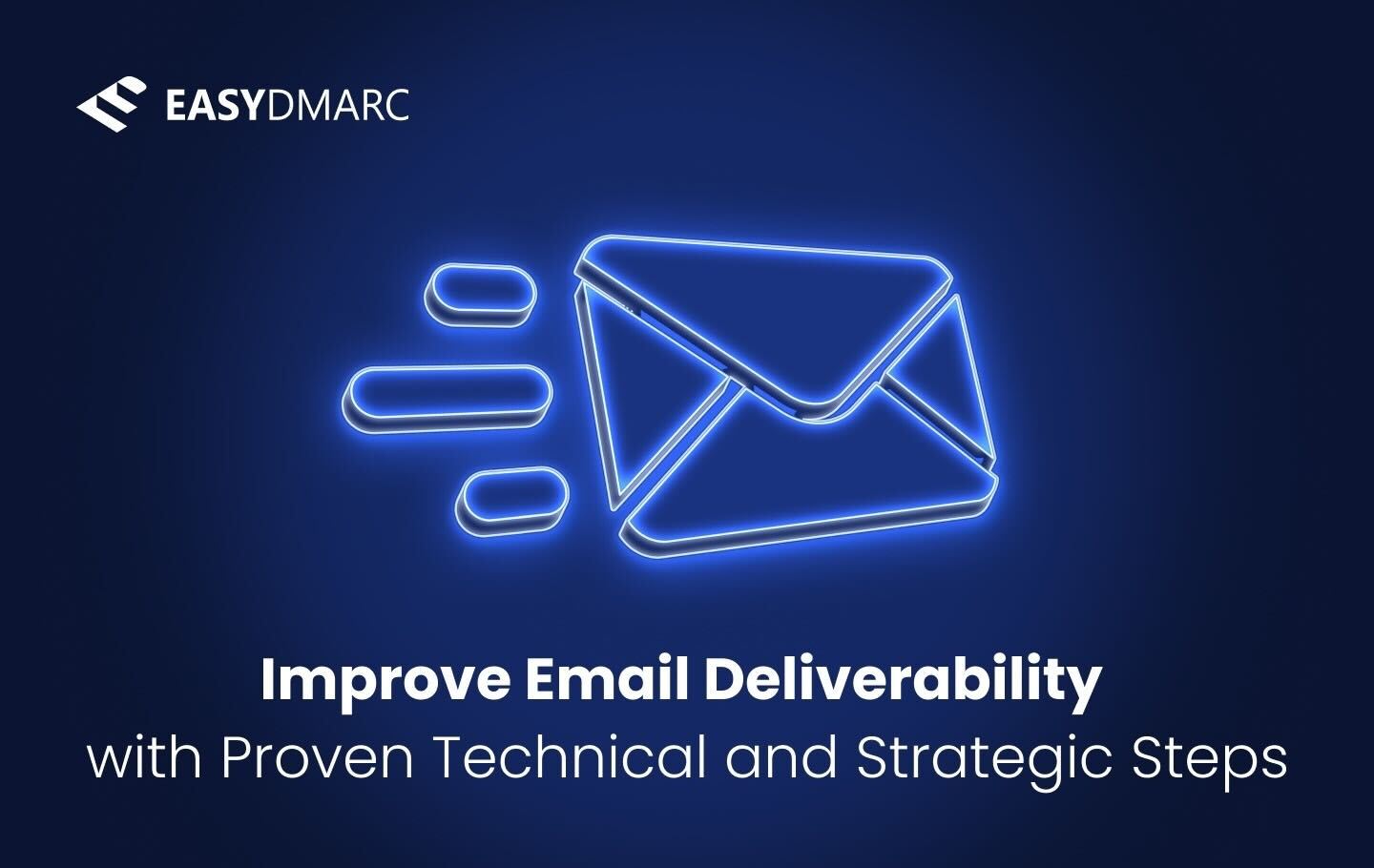When you send an email, the goal is for it to reach the inbox and be seen. Email deliverability determines how successfully that happens and directly affects the results of your campaigns. In this guide, we’ll walk through how to improve email deliverability using simple, effective steps, from setting up authentication and keeping your sender reputation strong to writing clear content and tracking engagement.
Authenticate Your Emails with SPF, DKIM & DMARC
If you want to improve email deliverability, the first step is to make sure your messages are properly authenticated. Authentication helps mailbox providers verify that your emails are legitimate and builds trust in your domain. The three main email authentication protocols, SPF, DKIM, and DMARC, work together to protect your domain and improve your chances of reaching the inbox.
SPF (Sender Policy Framework) tells receiving servers which sources are allowed to send messages on behalf of your domain. DKIM (DomainKeys Identified Mail) adds a digital signature that confirms the message wasn’t altered in transit. DMARC (Domain-based Message Authentication, Reporting, and Conformance) checks that SPF and DKIM are aligned and applies the policy you choose if a message fails authentication. Without proper alignment, even genuine messages can be flagged as suspicious or sent to spam, lowering your sender reputation.
Keeping your records clean and accurate is key to avoiding these problems. You can verify your configuration using EasyDMARC’s DMARC checker, SPF checker, and DKIM checker to identify misconfigurations early to ensure everything is up to date. DMARC also allows flexible enforcement levels, like none, quarantine, or reject, so you can begin with observation and move toward full protection without losing useful traffic.In its essence, reliable authentication directly strengthens your sender reputation and inbox placement. That assurance of trust is one of the main reasons why DMARC plays such a crucial role in DMARC email deliverability, helping organizations maintain both security and consistent inbox performance.
Maintain a Clean Sending Infrastructure & IP Reputation
A clean and stable sending setup plays a big role in how mailbox providers view your domain. Even with perfect content and authentication, your emails can still land in spam if your technical setup isn’t right. Building a strong foundation helps improve email deliverability and keeps your sender reputation healthy over time.
Your IP address is one of the first things email services check when deciding where to place your messages. With a shared IP, your reputation depends on everyone using that server, meaning someone else’s poor sending habits can affect your results. A dedicated IP, on the other hand, gives you full control but requires consistent sending to maintain trust. New domains or IPs also need “warming up,” which means gradually increasing your email volume so providers can recognize you as a legitimate sender.
Consistency across your DNS and “From” records also matters. If your domain name, subdomains, or hostnames don’t match your authentication setup, it can confuse filters and lower trust. Setting up reverse DNS and making sure your hostname points back to your sending IP helps confirm that your domain is real and reliable.
Practice List Hygiene & Segmentation
A healthy contact list is one of the strongest indicators of good sender reputation and directly helps improve email deliverability. Internet service providers (ISPs) and spam filters pay close attention to how recipients react to your messages. When you consistently send emails to valid and active contacts, you show that your messages are relevant and wanted, which earns more trust from mailbox providers.
Keep Your List Clean and Up to Date
Start by reviewing your list regularly and removing addresses that are no longer valid or engaged. Hard bounces happen when an address doesn’t exist, while soft bounces are usually caused by temporary issues, such as a full inbox or server error. If the same address keeps bouncing, it’s best to remove it instead of risking your sender reputation.
Pay attention to recipients who haven’t opened your emails for a long time. Re-engagement campaigns can help you win them back, but if they still remain inactive, it’s better to unsubscribe them automatically than continue sending unwanted messages.
Another important aspect of list hygiene is that ISPs and blocklist vendors often place spam traps within mailing lists to highlight expired or inactive email addresses. Sending emails to these addresses signals poor list hygiene and can harm your sender reputation. Regular email verification helps maintain proper list hygiene and reduces the risk of hitting spam traps, ultimately supporting a stronger sender reputation.
Segment Your Audience by Behavior and Interest
Segmentation is just as important as cleaning. By grouping contacts based on their interests, engagement history, or frequency preferences, you can send more personalized and meaningful content. For example, frequent buyers might receive product updates, while new subscribers get welcome tips or educational material. This keeps your open and click-through rates high, showing ISPs that your emails are valuable and relevant.
Maintain a Healthy Reputation Over Time
Good list hygiene and smart segmentation work hand in hand. They reduce spam complaints, keep bounce rates low, and make your campaigns more consistent in the long run. These habits are among the most effective email deliverability best practices — simple to manage and essential for building lasting trust with both mailbox providers and your audience.
Optimize Email Content & Formatting
Your email’s structure and style play a major role in how mailbox providers judge its credibility. Even with solid authentication and a clean sender reputation, the way your message looks, reads, and functions can still affect inbox placement. A well-balanced layout, clear language, and safe formatting all work together to improve email deliverability and help your messages make a positive first impression.
Subject Lines and Message Clarity
The subject line is the first thing both readers and filters see. Keep it short, specific, and relevant to your message. Avoid all caps, overuse of punctuation, or pushy phrases like “Buy now” or “Act fast.” Honest, clear subject lines encourage users to open your emails without triggering spam filters. Make sure your “From” name and address also match your brand, so recipients instantly recognize who’s contacting them.
Message Balance (Text vs. Visuals)
Emails made up mostly of images or oversized graphics often get flagged as risky, while plain text alone can look unpolished. Aim for a healthy mix: clear, concise text supported by meaningful visuals. Add alt text to images, keep file sizes small, and make sure your message still makes sense even if visuals don’t load. This balance signals to mailbox providers that your emails are legitimate and well-structured.
Link Formatting
Links tell filters a lot about your message’s intent. Always use clear, descriptive URLs that match your domain and stay away from shortened or misleading links. Make sure each link leads to a secure (HTTPS) and relevant page. Filters often block messages with broken or mismatched links, so checking them before sending is key. Following email security best practices also helps you maintain safe formatting and avoid patterns that resemble phishing or spam behavior.
Mobile Optimization
Since most people read emails on their phones, your design must adjust smoothly to smaller screens. Use a single-column layout, short paragraphs, large, clickable buttons, and an option for dark mode. Choose simple fonts and leave enough spacing for easy scrolling. Test your messages on both desktop and mobile before sending to catch any layout or alignment issues. A responsive, easy-to-navigate design improves user experience and engagement, strengthening your sender reputation and long-term deliverability.
Monitor Engagement Metrics and Feedback Loops
Understanding which strategy will improve email deliverability starts with looking at how your audience responds. Mailbox providers judge your reputation based on engagement, so consistent interaction tells them your messages are wanted and relevant, and worthy of landing in the inbox.
The key engagement metrics to watch are open rates, click-through rates, and spam complaints. A healthy open rate means your subject lines and timing match your audience’s interests. Clicks show that your content is useful and engaging, while spam complaints indicate problems that need quick attention. Even a small rise in complaint rates can affect your reputation, so it’s important to understand what triggers them, including too many emails, irrelevant content, or unclear unsubscribe options.
Many major email services, including Gmail, Postmaster and Yahoo, offer feedback loops that provide valuable data about how recipients react to your messages. These reports show patterns, such as which campaigns are being ignored or flagged as spam, helping you identify what to adjust. If you notice lower engagement, it may be time to refresh your content, review your segmentation, or slow down your sending frequency.
Another smart habit is removing or reducing communication with unengaged contacts. Continuously sending to people who don’t open or click sends a negative signal to mailbox providers. Instead, focus on the subscribers who interact with your messages. You can re-engage inactive users through targeted campaigns, but if there’s still no activity, it’s best to remove them to keep your list healthy.
Manage Bounces, Complaints, and Unsubscribes
Even the best-managed email strategy needs regular maintenance. Over time, some addresses become invalid, engagement levels change, and subscribers may decide they no longer want to receive your messages. How you handle these signals plays a big role in your sender reputation and overall performance. Managing bounces, complaints, and unsubscribes correctly is one of the most reliable ways to protect your domain and follow best practices for email deliverability.
- Bounces are common and come in two main types: soft and hard. Soft bounces usually result from temporary issues like a full inbox or a brief server problem, while hard bounces mean the address is permanently invalid. It’s best to retry soft bounces a few times and remove hard bounces right away. Continuing to send to invalid addresses signals to mailbox providers that your list isn’t properly maintained, which can lead to more of your messages being filtered out.
- Spam complaints are another factor that can quickly harm your reputation. When too many recipients report your emails as spam, it tells mailbox providers that your messages might be unwanted or irrelevant. To avoid this, make sure each email includes a simple, visible unsubscribe link and that you’re sending messages at a reasonable frequency. Allowing users to choose what kind of content they receive also helps reduce complaints and keeps your list more engaged.
- Unsubscribes should always be handled quickly and respectfully. Honoring opt-out requests isn’t just a good practice; it’s a legal requirement in most regions. Trying to hold onto disinterested contacts only increases spam complaints and lowers engagement. A smaller but active audience will always deliver better results than a large, unresponsive one.
Leverage Deliverability & Monitoring Tools
Keeping your email performance strong requires consistent monitoring. Deliverability tools like Postmaster Tools or EasySENDER help you track how well your authentication, reputation, and domain configuration are working together. These tools integrate with Google Postmaster, Amazon SES, and SendGrid, which allows you to monitor campaign performance, sender reputation, and authentication health over time.
Monitoring tools can also check if your SPF, DKIM, and DMARC records are properly aligned, alert you when your domain appears on a blocklist, and show how mailbox providers are responding to your emails. They also help identify issues like DNS misconfigurations or authentication gaps before they start affecting your sender reputation. By reviewing these reports regularly, you can take quick action to fix problems and maintain consistent deliverability.
EasyDMARC is a great example of how these tools simplify domain management and visibility. With built-in options like the DNS checker and email deliverability test, you can easily verify that your records are up to date and correctly configured. The platform also provides detailed reports on authentication results and domain health, helping you monitor changes over time and spot any early warning signs.
Using deliverability and monitoring tools consistently gives you full control over your email environment. Instead of reacting to problems after they happen, you can stay proactive — ensuring your authentication stays aligned, your domain remains trusted, and your email performance keeps improving.
Troubleshoot Deliverability Issues and Maintain Long-Term Health
A sudden drop in inbox placement can be frustrating, but it’s often a sign that something in your setup or strategy needs attention. The key is to find the root cause early and fix it before it starts affecting your reputation. Regular troubleshooting and maintenance are what keep your email program stable and your deliverability improving over time.
The first step is to analyze your recent results. Compare current open, click, and bounce rates with previous campaigns to spot unusual changes. If engagement has dropped sharply, check your technical setup, as expired SPF, DKIM, or DMARC records can easily cause issues. Misconfigured DNS records, missing alignments, or failed authentication checks are common reasons why legitimate emails get filtered out.
Reputation checks are just as important. Look into public blocklists to ensure your domain or IP hasn’t been flagged. Even one listing can limit inbox visibility until it’s resolved. If you’ve recently increased sending volume or changed content styles, mailbox providers may also adjust filtering until they re-establish trust in your new patterns.
To maintain long-term deliverability health, build troubleshooting into your regular routine. Schedule audits of your domain, authentication setup, and sending practices. Test new campaigns with small segments before full rollout and monitor how different inbox providers respond. Keeping a steady eye on your metrics and domain health allows you to catch small issues early, maintain consistency, and ensure your emails continue to reach their audience without interruption.
Strengthening Deliverability Is an Ongoing Process
Email deliverability isn’t a one-time setup, it’s something that needs regular care. Your authentication, content quality, engagement, and domain reputation all play a role in how mailbox providers treat your messages. Treating deliverability as a continuous process helps you stay ahead of problems and keep inbox placement consistent, even as email filters and user behavior change.
Monitor Technical Setup Regularly
Set a routine for reviewing your reports, DNS records, and email authentication setup. Small issues like expired SPF, DKIM, or DMARC records can quietly affect how your emails are delivered. Checking your authentication and DNS configuration every few weeks keeps your domain trusted and prevents sudden deliverability drops.
Track Engagement Trends
Engagement tells mailbox providers how relevant your content is. Monitor open rates, click-throughs, and spam complaints to see how well your audience responds. If interaction starts to fall, adjust your frequency, update subject lines, or refresh your segmentation. These small improvements help recover engagement and show providers that your messages remain valuable to readers.
Test and Audit Consistently
Regular testing helps you catch issues before they turn into bigger problems. Send small test campaigns to verify inbox placement, check how different providers handle your messages, and review any changes in your sender reputation. Periodic audits of your domain setup and deliverability reports ensure your strategy stays reliable and up to date.
Build Consistency Over Time
Strong deliverability comes from steady, proactive habits. By keeping your setup aligned, maintaining a healthy contact list, and watching your engagement metrics, you build long-term trust with mailbox providers. Consistency in both technical maintenance and communication is what keeps your messages reaching the people who matter most.
Frequently Asked Questions
The main factors affecting email deliverability are proper authentication, sender reputation, and engagement. Setting up SPF, DKIM, and DMARC correctly helps prove your emails are genuine. A strong reputation, built on clean lists and relevant content, tells mailbox providers your messages can be trusted and people opening and clicking your emails reinforces that trust.
Check your sender reputation at least once a month, or more often if you send high volumes of email. Regular reviews help catch small issues before they impact performance. Monitor bounce rates, spam complaints, and authentication results to stay aware of how mailbox providers view your domain.
Delivery rate shows how many emails reach recipients without bouncing, while inbox placement shows how many land in the main inbox instead of spam. You can have a high delivery rate but still poor placement if filters see your content as risky or irrelevant. Strong authentication and good engagement help improve both.
SPF authorizes which servers can send emails from your domain, DKIM adds a digital signature to verify message integrity, and DMARC checks that both are aligned. When configured correctly, these protocols protect your domain from spoofing and improve deliverability by confirming that your messages are legitimate.
Most deliverability issues come from configuration or reputation problems, not your email service provider. Cleaning your list, improving authentication, sending relevant content, and tracking engagement can make a big difference without switching platforms.


